Napoli
( Naples )
Naples ( NAY-pəlz; Italian: Napoli [ˈnaːpoli] ; Neapolitan: Napule [ˈnɑːpələ]) is the regional capital of Campania and the third-largest city of Italy, after Rome and Milan, with a population of 909,048 within the city's administrative limits as of 2022. Its province-level municipality is the third-most populous metropolitan city in Italy with a population of 3,115,320 residents, and its metropolitan area stretches beyond the boundaries of the city wall for approximately 30 kilometres (20 miles).
Founded by Greeks in the first millennium BC, Naples is one of the oldest continuously inhabited urban areas in the world. In the eighth century BC, a colony known as Parthenope (Ancient Greek: Παρθενόπη) was established on the Pizzo...Read more
Naples ( NAY-pəlz; Italian: Napoli [ˈnaːpoli] ; Neapolitan: Napule [ˈnɑːpələ]) is the regional capital of Campania and the third-largest city of Italy, after Rome and Milan, with a population of 909,048 within the city's administrative limits as of 2022. Its province-level municipality is the third-most populous metropolitan city in Italy with a population of 3,115,320 residents, and its metropolitan area stretches beyond the boundaries of the city wall for approximately 30 kilometres (20 miles).
Founded by Greeks in the first millennium BC, Naples is one of the oldest continuously inhabited urban areas in the world. In the eighth century BC, a colony known as Parthenope (Ancient Greek: Παρθενόπη) was established on the Pizzofalcone hill. In the sixth century BC, it was refounded as Neápolis. The city was an important part of Magna Graecia, played a major role in the merging of Greek and Roman society, and was a significant cultural centre under the Romans.
Naples served as the capital of the Duchy of Naples (661–1139), subsequently as the capital of the Kingdom of Naples (1282–1816), and finally as the capital of the Kingdom of the Two Sicilies — until the unification of Italy in 1861. Naples is also considered a capital of the Baroque, beginning with the artist Caravaggio's career in the 17th century and the artistic revolution he inspired. It was also an important centre of humanism and Enlightenment. The city has long been a global point of reference for classical music and opera through the Neapolitan School. Between 1925 and 1936, Naples was expanded and upgraded by Benito Mussolini's government. During the later years of World War II, it sustained severe damage from Allied bombing as they invaded the peninsula. The city underwent extensive reconstruction work after the war.
Since the late 20th century, Naples has had significant economic growth, helped by the construction of the Centro Direzionale business district and an advanced transportation network, which includes the Alta Velocità high-speed rail link to Rome and Salerno and an expanded subway network. Naples is the third-largest urban economy in Italy by GDP, after Milan and Rome. The Port of Naples is one of the most important in Europe. In addition to commercial activities, it is home to NATO's Allied Joint Force Command Naples and of the Parliamentary Assembly of the Mediterranean.
Naples' historic city centre is the largest in Europe and has been designated as a UNESCO World Heritage Site. A wide range of culturally and historically significant sites are nearby, including the Palace of Caserta and the Roman ruins of Pompeii and Herculaneum. Naples is also known for its natural beauties, such as Posillipo, Phlegraean Fields, Nisida and Vesuvius. Neapolitan cuisine is noted for its association with pizza, which originated in the city, as well as numerous other local dishes. Restaurants in the Naples' area have earned the most stars from the Michelin Guide of any Italian province. Naples' Centro Direzionale was built in 1994 as the first grouping of skyscrapers in Italy, remaining the only such grouping in Italy until 2009. The most widely-known sports team in Naples is the Serie A football club Napoli, three-time Italian champions (most recently in 2023), who play at the Stadio Diego Armando Maradona in the west of the city, in the Fuorigrotta quarter.
 Mount Echia, the place where the polis of Parthenope arose
Mount Echia, the place where the polis of Parthenope arose The Columns of the Temple of Castor and Pollux incorporated into the facade of San Paolo Maggiore
The Columns of the Temple of Castor and Pollux incorporated into the facade of San Paolo Maggiore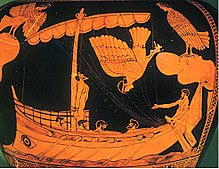 A scene featuring the siren Parthenope, the mythological founder of Naples[1]
A scene featuring the siren Parthenope, the mythological founder of Naples[1]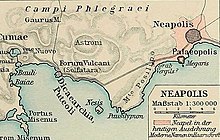 Map of pre-Roman Neapolis
Map of pre-Roman NeapolisNaples has been inhabited since the Neolithic period.[2] In the second millennium BC, a first Mycenaean settlement arose not far from the geographical position of the future city of Parthenope.[3]
Sailors from the Greek island of Rhodes established probably a small commercial port called Parthenope (Παρθενόπη, meaning "Pure Eyes", a Siren in Greek mythology) on the island of Megaride in the ninth century BC.[4] By the eighth century BC, the settlement was expanded by Cumaeans, as evidenced by the archaeological findings, to include Monte Echia.[5] In the sixth century BC the city was refounded as Neápolis (Νεάπολις), eventually becoming one of the foremost cities of Magna Graecia.[6]
The city grew rapidly due to the influence of the powerful Greek city-state of Syracuse,[7] and became an ally of the Roman Republic against Carthage. During the Samnite Wars, the city, now a bustling centre of trade, was captured by the Samnites;[8] however, the Romans soon captured the city from them and made it a Roman colony.[9] During the Punic Wars, the strong walls surrounding Neápolis repelled the invading forces of the Carthaginian general Hannibal.[9]
The Romans greatly respected Naples as a paragon of Hellenistic culture. During the Roman era, the people of Naples maintained their Greek language and customs. At the same time, the city was expanded with elegant Roman villas, aqueducts, and public baths. Landmarks such as the Temple of Dioscures were built, and many emperors chose to holiday in the city, including Claudius and Tiberius.[9] Virgil, the author of Rome's national epic, the Aeneid, received part of his education in the city, and later resided in its environs.
It was during this period that Christianity first arrived in Naples; the apostles Peter and Paul are said to have preached in the city. Januarius, who would become Naples' patron saint, was martyred there in the fourth century AD.[10] The last emperor of the Western Roman Empire, Romulus Augustulus, was exiled to Naples by the Germanic king Odoacer in the fifth century AD.
Duchy of Naples The Gothic Battle of Mons Lactarius on Vesuvius, painted by Alexander Zick
The Gothic Battle of Mons Lactarius on Vesuvius, painted by Alexander ZickFollowing the decline of the Western Roman Empire, Naples was captured by the Ostrogoths, a Germanic people, and incorporated into the Ostrogothic Kingdom.[11] However, Belisarius of the Byzantine Empire recaptured Naples in 536, after entering the city via an aqueduct.[12]
In 543, during the Gothic Wars, Totila briefly took the city for the Ostrogoths, but the Byzantines seized control of the area following the Battle of Mons Lactarius on the slopes of Vesuvius.[11] Naples was expected to keep in contact with the Exarchate of Ravenna, which was the centre of Byzantine power on the Italian Peninsula.[13]
After the exarchate fell, a Duchy of Naples was created. Although Naples' Greco-Roman culture endured, it eventually switched allegiance from Constantinople to Rome under Duke Stephen II, putting it under papal suzerainty by 763.[13]
The years between 818 and 832 saw tumultuous relations with the Byzantine Emperor, with numerous local pretenders feuding for possession of the ducal throne.[14] Theoctistus was appointed without imperial approval; his appointment was later revoked and Theodore II took his place. However, the disgruntled general populace chased him from the city and elected Stephen III instead, a man who minted coins with his initials rather than those of the Byzantine Emperor. Naples gained complete independence by the early ninth century.[14] Naples allied with the Muslim Saracens in 836 and asked for their support to repel the siege of Lombard troops coming from the neighbouring Duchy of Benevento. However, during the 850s, Muslim general Muhammad I Abu 'l-Abbas sacked Miseno, but only for Khums purposes (Islamic booty), without conquering the territories of Campania.[15][16]
The duchy was under the direct control of the Lombards for a brief period after the capture by Pandulf IV of the Principality of Capua, a long-term rival of Naples; however, this regime lasted only three years before the Greco-Roman-influenced dukes were reinstated.[14] By the 11th century, Naples had begun to employ Norman mercenaries to battle their rivals; Duke Sergius IV hired Rainulf Drengot to wage war on Capua for him.[17]
By 1137, the Normans had attained great influence in Italy, controlling previously independent principalities and duchies such as Capua, Benevento, Salerno, Amalfi, Sorrento and Gaeta; it was in this year that Naples, the last independent duchy in the southern part of the peninsula, came under Norman control. The last ruling duke of the duchy, Sergius VII, was forced to surrender to Roger II, who had been proclaimed King of Sicily by Antipope Anacletus II seven years earlier. Naples thus joined the Kingdom of Sicily, with Palermo as the capital.[18]
As part of the Kingdom of Sicily Frederick II
Frederick IIAfter a period of Norman rule, in 1189 the Kingdom of Sicily was in a succession dispute between Tancred, King of Sicily of an illegitimate birth and the Hohenstaufens, a Germanic royal house,[19] as its Prince Henry had married Princess Constance the last legitimate heir to the Sicilian throne. In 1191 Henry invaded Sicily after being crowned as Henry VI, Holy Roman Emperor, and many cities surrendered. Still, Naples resisted him from May to August under the leadership of Richard, Count of Acerra, Nicholas of Ajello, Aligerno Cottone and Margaritus of Brindisi before the Germans suffered from disease and were forced to retreat. Conrad II, Duke of Bohemia and Philip I, Archbishop of Cologne died of disease during the siege. During his counterattack, Tancred captured Constance, now empress. He had the empress imprisoned at Castel dell'Ovo at Naples before her release on May 1192 under the pressure of Pope Celestine III. In 1194 Henry started his second campaign upon the death of Tancred, but this time Aligerno surrendered without resistance, and finally, Henry conquered Sicily, putting it under the rule of Hohenstaufens.
The University of Naples, the first university in Europe dedicated to training secular administrators,[20] was founded by Frederick II, making Naples the intellectual centre of the kingdom. Conflict between the Hohenstaufens and the Papacy led in 1266 to Pope Innocent IV crowning the Angevin duke Charles I King of Sicily:[21] Charles officially moved the capital from Palermo to Naples, where he resided at the Castel Nuovo.[22] Having a great interest in architecture, Charles I imported French architects and workmen and was personally involved in several building projects in the city.[23] Many examples of Gothic architecture sprang up around Naples, including the Naples Cathedral, which remains the city's main church.[24]
Kingdom of Naples The Castel Nuovo, a.k.a. Maschio Angioino, a seat of medieval kings of Naples, Aragon and Spain
The Castel Nuovo, a.k.a. Maschio Angioino, a seat of medieval kings of Naples, Aragon and SpainIn 1282, after the Sicilian Vespers, the Kingdom of Sicily was divided into two. The Angevin Kingdom of Naples included the southern part of the Italian peninsula, while the island of Sicily became the Aragonese Kingdom of Sicily.[21] Wars between the competing dynasties continued until the Peace of Caltabellotta in 1302, which saw Frederick III recognised as king of Sicily, while Charles II was recognised as king of Naples by Pope Boniface VIII.[21] Despite the split, Naples grew in importance, attracting Pisan and Genoese merchants,[25] Tuscan bankers, and some of the most prominent Renaissance artists of the time, such as Boccaccio, Petrarch and Giotto.[26] During the 14th century, the Hungarian Angevin king Louis the Great captured the city several times. In 1442, Alfonso I conquered Naples after his victory against the last Angevin king, René, and Naples was unified with Sicily again for a brief period.[27]
Aragonese and SpanishSicily and Naples were separated since 1282, but remained dependencies of Aragon under Ferdinand I.[28] The new dynasty enhanced Naples' commercial standing by establishing relations with the Iberian Peninsula. Naples also became a centre of the Renaissance, with artists such as Laurana, da Messina, Sannazzaro and Poliziano arriving in the city.[29] In 1501, Naples came under direct rule from France under Louis XII, with the Neapolitan king Frederick being taken as a prisoner to France; however, this state of affairs did not last long, as Spain won Naples from the French at the Battle of Garigliano in 1503.[30]
 The Viceroy of Naples paying tribute to De Ruyter's fleet in the port of Naples, 1676, by Jan van Essen.
The Viceroy of Naples paying tribute to De Ruyter's fleet in the port of Naples, 1676, by Jan van Essen. View of the Bay of Naples with Admiral Byng's Fleet at Anchor, 1718. Painting by Gaspar Butler.
View of the Bay of Naples with Admiral Byng's Fleet at Anchor, 1718. Painting by Gaspar Butler.Following the Spanish victory, Naples became part of the Spanish Empire, and remained so throughout the Spanish Habsburg period.[30] The Spanish sent viceroys to Naples to directly deal with local issues: the most important of these viceroys was Pedro Álvarez de Toledo, who was responsible for considerable social, economic and urban reforms in the city; he also tried to introduce the Inquisition.[31][better source needed] In 1544, around 7,000 people were taken as slaves by Barbary pirates and brought to the Barbary Coast of North Africa (see Sack of Naples).[32]
By the 17th century, Naples had become Europe's second-largest city – second only to Paris – and the largest European Mediterranean city, with around 250,000 inhabitants.[33] The city was a major cultural centre during the Baroque era, being home to artists such as Caravaggio, Salvator Rosa and Bernini, philosophers such as Bernardino Telesio, Giordano Bruno, Tommaso Campanella and Giambattista Vico, and writers such as Giambattista Marino. A revolution led by the local fisherman Masaniello saw the creation of a brief independent Neapolitan Republic in 1647. However, this lasted only a few months before Spanish rule was reasserted.[30] In 1656, an outbreak of bubonic plague killed about half of Naples' 300,000 inhabitants.[34]
 Departure of Charles III of Spain from Naples, 1759
Departure of Charles III of Spain from Naples, 1759In 1714, Spanish rule over Naples came to an end as a result of the War of the Spanish Succession; the Austrian Charles VI ruled the city from Vienna through viceroys of his own.[35] However, the War of the Polish Succession saw the Spanish regain Sicily and Naples as part of a personal union, with the 1738 Treaty of Vienna recognising the two polities as independent under a cadet branch of the Spanish Bourbons.[36]
In 1755, the Duke of Noja commissioned an accurate topographic map of Naples, later known as the Map of the Duke of Noja, employing rigorous surveying accuracy and becoming an essential urban planning tool for Naples.
During the time of Ferdinand IV, the effects of the French Revolution were felt in Naples: Horatio Nelson, an ally of the Bourbons, arrived in the city in 1798 to warn against the French republicans. Ferdinand was forced to retreat and fled to Palermo, where he was protected by a British fleet.[37] However, Naples' lower class lazzaroni were strongly pious and royalist, favouring the Bourbons; in the mêlée that followed, they fought the Neapolitan pro-Republican aristocracy, causing a civil war.[37]
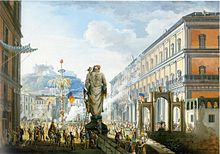 Naples depicted during the ephemeral Parthenopean Republic
Naples depicted during the ephemeral Parthenopean RepublicEventually, the Republicans conquered Castel Sant'Elmo and proclaimed a Parthenopaean Republic, secured by the French Army.[37] A counter-revolutionary religious army of lazzaroni known as the sanfedisti under Cardinal Fabrizio Ruffo was raised; they met with great success, and the French were forced to surrender the Neapolitan castles, with their fleet sailing back to Toulon.[37]
Ferdinand IV was restored as king; however, after only seven years, Napoleon conquered the kingdom and installed Bonapartist kings, including installing his brother Joseph Bonaparte.[38] With the help of the Austrian Empire and its allies, the Bonapartists were defeated in the Neapolitan War. Ferdinand IV once again regained the throne and the kingdom.[38]
Independent Two SiciliesThe Congress of Vienna in 1815 saw the kingdoms of Naples and Sicily combine to form the Kingdom of the Two Sicilies,[38] with Naples as the capital city. In 1839, Naples became the first city on the Italian peninsula to have a railway, with the construction of the Naples–Portici railway.[39]
Italian unification to the present day Entrance of Garibaldi into Naples on 7 September 1860
Entrance of Garibaldi into Naples on 7 September 1860After the Expedition of the Thousand led by Giuseppe Garibaldi, which culminated in the controversial siege of Gaeta, Naples became part of the Kingdom of Italy in 1861 as part of the Italian unification, ending the era of Bourbon rule. The economy of the area formerly known as the Two Sicilies as dependant on agriculture suffered the international pressure on prices of wheat, and together with lower sea fares prices lead to an unprecedented wave of emigration,[40] with an estimated 4 million people emigrating from the Naples area between 1876 and 1913.[41] In the forty years following unification, the population of Naples grew by only 26%, vs. 63% for Turin and 103% for Milan; however, by 1884, Naples was still the largest city in Italy with 496,499 inhabitants, or roughly 64,000 per square kilometre (more than twice the population density of Paris).[42]: 11–14, 18
Public health conditions in certain areas of the city were poor, with twelve epidemics of cholera and typhoid fever claiming some 48,000 people between 1834 and 1884. A death rate 31.84 per thousand, high even for the time, insisted in the absence of epidemics between 1878 and 1883.[42] Then in 1884, Naples fell victim to a major cholera epidemic, caused largely by the city's poor sewerage infrastructure. In response to these problems, in 1852, the government prompted a radical transformation of the city called risanamento to improve the sewerage infrastructure and replace the most clustered areas, considered the main cause of insalubrity, with large and airy avenues. The project proved difficult to accomplish politically and economically due to corruption, as shown in the Saredo Inquiry, land speculation and extremely long bureaucracy. This led to the project to massive delays with contrasting results. The most notable transformations made were the construction of Via Caracciolo in place of the beach along the promenade, the creation of Galleria Umberto I and Galleria Principe and the construction of Corso Umberto.[43][44]
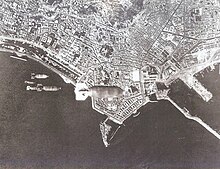 Allied bombardment of Naples, 1943
Allied bombardment of Naples, 1943Naples was the most-bombed Italian city during World War II.[45] Though Neapolitans did not rebel under Italian Fascism, Naples was the first Italian city to rise up against German military occupation; the city was completely freed by 1 October 1943, when British and American forces entered the city.[46] Departing Germans burned the library of the university, as well as the Italian Royal Society. They also destroyed the city archives. Time bombs planted throughout the city continued to explode into November.[47] The symbol of the rebirth of Naples was the rebuilding of the church of Santa Chiara, which had been destroyed in a United States Army Air Corps bombing raid.[45]
Special funding from the Italian government's Fund for the South was provided from 1950 to 1984, helping the Neapolitan economy to improve somewhat, with city landmarks such as the Piazza del Plebiscito being renovated.[48] However, high unemployment continues to affect Naples.
Italian media attributed the past city's waste disposal issues to the activity of the Camorra organised crime network.[49] Due to this event, environmental contamination and increased health risks are also prevalent.[50] In 2007, Silvio Berlusconi's government held senior meetings in Naples to demonstrate their intention to solve these problems.[51] However, the late-2000s recession had a severe impact on the city, intensifying its waste-management and unemployment problems.[52] By August 2011, the number of unemployed in the Naples area had risen to 250,000, sparking public protests against the economic situation.[53] In June 2012, allegations of blackmail, extortion, and illicit contract tendering emerged concerning the city's waste management issues.[54][55]
Naples hosted the sixth World Urban Forum in September 2012[56] and the 63rd International Astronautical Congress in October 2012.[57] In 2013, it was the host of the Universal Forum of Cultures and the host for the 2019 Summer Universiade.












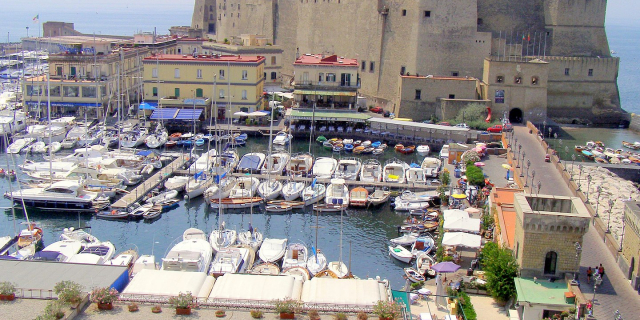












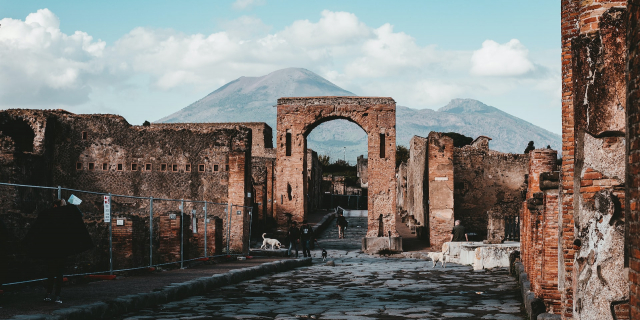







Add new comment